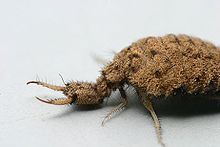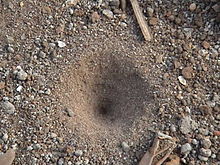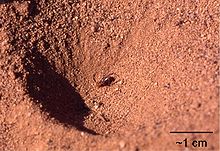Ant lion optimizer

The Ant Lion Optimizer, known as ALO or Antlion Optimizer [1], is a recent meta-heuristic that mathematically models the interaction of ants and antlions in nature. An optimization algorithm has been developed to solve optimization problems considering random walk of ants, building traps, entrapment of ants in traps, catching preys, and re-building traps are implemented.
Inspiration
[edit | edit source]
Antlions are knowns as doodlebugs sometimes. They are under the Myrmeleontidae family and live in two phases of larvae and adult. Their hunt mechanism is interesting when they are larvae. The small cone-shape trapped that we see in nature are made by antlions to trap ants. Antlions sit under the pit and wait for prey to be trapped. After consuming the prey’s flesh, antlions throw the leftovers outside the pit and amend the pit for the next hunt. It has been observed that antlions tend to dig a bigger pit when they are hungry and this is exactly the main inspiration for ALO algorithm.
Operators of the ALO algorithm
[edit | edit source]As mentioned above, the ALO algorithm simulates five main steps of hunts in larvae: random walk of ants, building traps, entrapment of ants in traps, catching preys, and re-building traps are implemented. The following paragraphs and sub-sections present the mathematical models:
The main random walk in this algorithm is as follows:
where cumsum calculates the cumulative sum, n is the maximum number of iteration, t shows the step of random walk (iteration in this study), r(t) is a stochastic function and rand is a random number generated with uniform distribution in the interval of [0, 1].
The location of ants should be stored in the following matrix:
where is the matrix for saving the position of each ant, shows the value of the j-th variable (dimension) of i-th ant, n is the number of ants, and d is the number of variables.
The corresponding objective value for each antlion is calculated and stored in the following matricx:
where is the matrix for saving the fitness of each ant, shows the value of j-th dimension of i-th ant, n is the number of ants, and is the objective function. In ALO, it is assumed that the antlions also hide somewhere in the search space. To save their positions and fitness values, the following matrices are utilized:
where is the matrix for saving the fitness of each antlion, shows the j-th dimension’s value of i-th antlion, n is the number of antlions, and is the objective function.
Random walks of ants
[edit | edit source]The random walk discussed above is used in the following equation to update the position of ants:
where is the minimum of random walk of i-th variable, is the maximum of random walk in i-th variable, is the minimum of i-th variable at t-th iteration, and indicates the maximum of i-th variable at t-th iteration.

Trapping in antlion’s pits
[edit | edit source]The impact of antlions on the movement of ants is modelled as follows:
where is the minimum of all variables at t-th iteration, indicates the vector including the maximum of all variables at t-th iteration, View the MathML source is the minimum of all variables for i-th ant, View the MathML source is the maximum of all variables for i-th ant, and View the MathML source shows the position of the selected j-th antlion at t-th iteration.
Building trap
[edit | edit source]Building traps is done with a roulette wheel is employed. The roulette wheel operator selects antlions based of their fitness during optimization. This mechanism gives high chances to the fitter antlions for catching ants.
Sliding ants towards antlion
[edit | edit source]
The mathematical model of this step of hut is given below. It may be seen in the equation that the radius of ants’s random walks hyper-sphere is decreased adaptively.
where I is a ratio, ct is the minimum of all variables at t-th iteration, and dt indicates the vector including the maximum of all variables at t-th iteration.
Catching prey and re-building the pit
[edit | edit source]In ALO, catching prey occurs when ants get fitter (dives inside the sand) than its associated antlion. An antlion is then required to update its position to the latest position of the hunted ant to enhance its chance of catching new prey. The following equation simulates this behaviour:
where t shows the current iteration, View the MathML source shows the position of selected j-th antlion at t-th iteration, and View the MathML source indicates the position of i-th ant at t-th iteration.
Elitism
[edit | edit source]Elitism is an important characteristic of evolutionary algorithms that allows them to maintain the best solution(s) obtained at any stage of optimization process. In this study the best antlion obtained so far in each iteration is saved and considered as an elite. Since the elite is the fittest antlion, it should be able to affect the movements of all the ants during iterations. Therefore, it is assumed that every ant randomly walks around a selected antlion by the roulette wheel and the elite simultaneously as follows:
where Rt A is the random walk around the antlion selected by the roulette wheel at t-th iteration, Rt E is the random walk around the elite at t-th iteration, and Antti indicates the position of i-th ant at t-th iteration.
Binary ALO
[edit | edit source]The binary version of ALO called BALO [2] uses a threshold function to solve discrete optimization problems.
Multi-objective ALO
[edit | edit source]The multi-objective version of ALO called MOLAO [3] has been proposed to solve multi-objective problems. MOALO uses an archive to store and improve Pareto optimal fronts.
Applications
[edit | edit source]ALO has been widely used in the literature to solve a variety of problems. some of the applications are:
Automatic generation control of a multi-area system [4]
Optimum design of skeletal structures [5]
Optimal load dispatch problem [6]
Flexible process planning [7]
Non-convex economic load dispatch problem for small-scale power systems [8]
Multi-objective optimum generation scheduling [9]
Training Neural Networks [10]
Route planning for unmanned aerial vehicle [11]
Regulator in Automatic Generation Control of Interconnected Power System [12]
Integrated Process Planning and Scheduling [13]
Hydro-thermal-wind scheduling [14]
Optimal community detection [15]
control side lobe level and null depths in linear antenna arrays [16]
Load Frequency Control of Multi-Area Interconnected Power Systems [17]
Structural design problems [18]
Optimal power flow with enhancement of voltage stability and reduction of power loss [19]
MPPT of a Partially Shaded Photovoltaic Module [22]
Unified Reliability Centric Preventive Generator Maintenance Scheduling Measure [23]
optimal reactive power dispatch solution [24]
Reactive and Active Power Loss Reduction [25]
Complex power setting for optimal power flow problem [26]
Power System Engineering [27]
Multi-Objective Distribution Network Operation Based on Distributed Generation Optimal Placement [28]
A multi-objective optimal sizing and siting of distributed generation [29]
Efficient Modeling of Linear Discrete Filters [30]
Optimum VAr planning problem [31]
Optimal location and sizing of renewable distributed generations [32]
Optimal real power rescheduling of generators for congestion management [33]
Segmentation for MRI Liver Images [34]
Renewable Distributed Generations [35]
FOPID controller for Speed control and Torque ripple minimization of SRM Drive System [36]
Segmentation for MRI Liver Images [37]
Cost/Reliability Evaluation [38]
Voltage stability enhancement and Voltage Deviation Minimization [39]
Generator maintenance scheduling [40]
Optimal allocation and sizing of renewable distributed generation [41]
AUV sensor selection [42]
References
[edit | edit source]- ↑ Mirjalili, Seyedali. "The ant lion optimizer." Advances in Engineering Software 83 (2015): 80-98.
- ↑ Emary, E., Hossam M. Zawbaa, and Aboul Ella Hassanien. "Binary ant lion approaches for feature selection." Neurocomputing 213 (2016): 54-65.
- ↑ Mirjalili, Seyedali, Pradeep Jangir, and Shahrzad Saremi. "Multi-objective ant lion optimizer: a multi-objective optimization algorithm for solving engineering problems." Applied Intelligence 46.1 (2017): 79-95.
- ↑ Raju, More, Lalit Chandra Saikia, and Nidul Sinha. "Automatic generation control of a multi-area system using ant lion optimizer algorithm based PID plus second order derivative controller." International Journal of Electrical Power & Energy Systems 80 (2016): 52-63.
- ↑ Talatahari, S. "Optimum design of skeletal structures using ant lion optimizer." Iran University of Science & Technology 6.1 (2016): 13-25.
- ↑ Nischal, Menakshi Mahendru, and Shivani Mehta. "Optimal load dispatch using ant lion optimization." Int J Eng Res Appl 5.8 (2015): 10-19.
- ↑ Petrović, M., et al. "The ant lion optimization algorithm for flexible process planning." JPE 18.2 (2015): 65-68.
- ↑ Kamboj, Vikram Kumar, Ashutosh Bhadoria, and S. K. Bath. "Solution of non-convex economic load dispatch problem for small-scale power systems using ant lion optimizer." Neural Computing and Applications (2016): 1-12.
- ↑ Chopra, Nitish, and Shivani Mehta. "Multi-objective optimum generation scheduling using Ant Lion Optimization." India Conference (INDICON), 2015 Annual IEEE. IEEE, 2015.
- ↑ Yamany, Waleed, et al. "A new multi-layer perceptrons trainer based on ant lion optimization algorithm." Information Science and Industrial Applications (ISI), 2015 Fourth International Conference on. IEEE, 2015.
- ↑ Yao, Peng, and Honglun Wang. "Dynamic Adaptive Ant Lion Optimizer applied to route planning for unmanned aerial vehicle." Soft Computing (2016): 1-14.
- ↑ Gupta, Esha, and Akash Saxena. "Performance Evaluation of Antlion Optimizer Based Regulator in Automatic Generation Control of Interconnected Power System." Journal of Engineering 2016 (2016).
- ↑ Petrović, Milica, et al. "The Ant Lion Optimization Algorithm for Integrated Process Planning and Scheduling." Applied Mechanics & Materials 834 (2016).
- ↑ Dubey, Hari Mohan, Manjaree Pandit, and B. K. Panigrahi. "Hydro-thermal-wind scheduling employing novel ant lion optimization technique with composite ranking index." Renewable Energy 99 (2016): 18-34.
- ↑ Babers, Ramadan, et al. "Optimal community detection approach based on Ant Lion Optimization." Computer Engineering Conference (ICENCO), 2015 11th International. IEEE, 2015.
- ↑ Saxena, Prerna, and Ashwin Kothari. "Ant Lion Optimization algorithm to control side lobe level and null depths in linear antenna arrays." AEU-International Journal of Electronics and Communications 70.9 (2016): 1339-1349.
- ↑ Satheeshkumar, R., and R. Shivakumar. "Ant Lion Optimization Approach for Load Frequency Control of Multi-Area Interconnected Power Systems." Circuits and Systems 7.09 (2016): 2357.
- ↑ Yıldız, Betül Sultan. "A comparative investigation of eight recent population-based optimisation algorithms for mechanical and structural design problems." International Journal of Vehicle Design 73.1-3 (2017): 208-218.
- ↑ Trivedi, Indrajit N., Pradeep Jangir, and Siddharth A. Parmar. "Optimal power flow with enhancement of voltage stability and reduction of power loss using ant-lion optimizer." Cogent Engineering 3.1 (2016): 1208942.
- ↑ Zawbaa, Hossam M., E. Emary, and Crina Grosan. "Feature selection via chaotic antlion optimization." PloS one 11.3 (2016): e0150652.
- ↑ Zawbaa, Hossam M., E. Emary, and B. Parv. "Feature selection based on antlion optimization algorithm." Complex Systems (WCCS), 2015 Third World Conference on. IEEE, 2015.
- ↑ Engel, Ekaterina A., and Igor V. Kovalev. "MPPT of a Partially Shaded Photovoltaic Module by Ant Lion Optimizer." International Conference in Swarm Intelligence. Springer International Publishing, 2016.
- ↑ Umamaheswari, E., et al. "An Unified Reliability Centric Preventive Generator Maintenance Scheduling Measure using Fuzzy Decision Mechanism based Ant Lion Optimiser." IET Science, Measurement & Technology (2017).
- ↑ Ng, Rebecca, and Shin Mei. "Selected paper Ant lion optimizer for optimal reactive power dispatch solution."
- ↑ Parmar, Siddharth A., et al. "Reactive and Active Power Loss Reduction using Ant-Lion Optimizer."
- ↑ Radha, J., et al. "Best Complex Power Settings Using Ant Lion Optimizer for Optimal Power Flow Problem." IUP Journal of Electrical and Electronics Engineering 9.3 (2016): 7.
- ↑ Trivedi, I. N., et al. "Power System Engineering Optimization using Ant Lion Optimizer."
- ↑ Javad, K. H. A. N. B. A. B. A. Z. A. D. E. H., and T. A. L. A. V. A. T. Vahid. "Multi-Objective Distribution Network Operation Based on Distributed Generation Optimal Placement Using New Antlion Optimizer Considering Reliability." Journal of Electrical & Electronics Engineering 9.2 (2016).
- ↑ Hadidian-Moghaddam, Mohammad Jafar, et al. "A multi-objective optimal sizing and siting of distributed generation using ant lion optimization technique." Ain Shams Engineering Journal (2017).
- ↑ Nair, Sreejith S., et al. "Efficient Modeling of Linear Discrete Filters Using Ant Lion Optimizer." Circuits, Systems, and Signal Processing (2016): 1-34.
- ↑ Rajan, Abhishek, K. Jeevan, and T. Malakar. "Weighted elitism based Ant Lion Optimizer to solve optimum VAr planning problem." Applied Soft Computing 55 (2017): 352-370.
- ↑ Ali, E. S., SM Abd Elazim, and A. Y. Abdelaziz. "Ant Lion Optimization Algorithm for optimal location and sizing of renewable distributed generations." Renewable Energy 101 (2017): 1311-1324.
- ↑ Verma, Sumit, and Vivekananda Mukherjee. "Optimal real power rescheduling of generators for congestion management using a novel ant lion optimiser." IET Generation, Transmission & Distribution 10.10 (2016): 2548-2561.
- ↑ Hassanien, Aboul Ella, Hesham Hefny, and Pei-Wei Tsai. "Antlion Optimization Based Segmentation for MRI Liver Images." Genetic and Evolutionary Computing: Proceedings of the Tenth International Conference on Genetic and Evolutionary Computing, November 7-9, 2016 Fuzhou City, Fujian Province, China. Vol. 536. Springer, 2016.
- ↑ Ali, E. S., SM Abd Elazim, and A. Y. Abdelaziz. "Ant Lion Optimization Algorithm for Renewable Distributed Generations." Energy 116 (2016): 445-458.
- ↑ Prasad, E. Shiva, and BV Sanker Ram. "Ant-Lion Optimizer algorithm based FOPID controller for Speed control and Torque ripple minimization of SRM Drive System."
- ↑ Mostafa, Abdalla, et al. "Antlion Optimization Based Segmentation for MRI Liver Images." International Conference on Genetic and Evolutionary Computing. Springer International Publishing, 2016.
- ↑ Davoudkhani, Iraj Faraji, and Ali Dastjerdi. "Hybrid System Optimal Designing Using New Ant Lion Optimization Algorithm Considering Cost/Reliability Evaluation."
- ↑ Trivedi, Indrajit N., et al. "Voltage stability enhancement and Voltage Deviation Minimization using ant-lion optimizer algorithm." Advances in Electrical, Electronics, Information, Communication and Bio-Informatics (AEEICB), 2016 2nd International Conference on. IEEE, 2016.
- ↑ Umamaheswari, E., et al. "Deterministic reliability model based preventive generator maintenance scheduling using Ant Lion Optimizer." Circuit, Power and Computing Technologies (ICCPCT), 2016 International Conference on. IEEE, 2016.
- ↑ Ali, E. S., SM Abd Elazim, and A. Y. Abdelaziz. "Optimal allocation and sizing of renewable distributed generation using ant lion optimization algorithm." Electrical Engineering (2016): 1-11.
- ↑ خویشه, محمد, et al. "انتخاب حسگرهای AUV با استفاده از الگوریتم ALO و شبکههای عصبی." فصلنامه علوم و فناوری دریا 77.77 (2016): 59-69.

![{\displaystyle X(t)=[0,cumsum(2r(t_{1})-1),cumsum(2r(t_{2})-1),...,cumsum(2r(t_{n})-1),]}](https://wikimedia.org/api/rest_v1/media/math/render/svg/ec2517bfd6dff8ee5ca1185dbd46b94107cb149e)




![{\displaystyle M_{OA}={\begin{bmatrix}f([A_{1,1},A_{1,2},...,A_{1,d}])\\f([A_{2,1},A_{2,2},...,A_{2,d}])\\...\\...\\f([A_{n,1},A_{n,2},...,A_{n,d}])\end{bmatrix}}}](https://wikimedia.org/api/rest_v1/media/math/render/svg/b54e5723f9b7e008d6875cb2bf501cfcbe766d7a)


![{\displaystyle M_{OAL}={\begin{bmatrix}f([AL_{1,1},AL_{1,2},...,AL_{1,d}])\\f([AL_{2,1},AL_{2,2},...,AL_{2,d}])\\...\\...\\f([AL_{n,1},AL_{n,2},...,AL_{n,d}])\end{bmatrix}}}](https://wikimedia.org/api/rest_v1/media/math/render/svg/fa107e154c4b0dc6892d9f289dd432834aaef3be)














